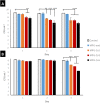Highly porous phosphate-based glasses for controlled delivery of antibacterial Cu ions prepared via sol-gel chemistry
- PMID: 37396829
- PMCID: PMC10308344
- DOI: 10.1039/d3ra02958a
Highly porous phosphate-based glasses for controlled delivery of antibacterial Cu ions prepared via sol-gel chemistry
Abstract
Mesoporous glasses are a promising class of bioresorbable biomaterials characterized by high surface area and extended porosity in the range of 2 to 50 nm. These peculiar properties make them ideal materials for the controlled release of therapeutic ions and molecules. Whilst mesoporous silicate-based glasses (MSG) have been widely investigated, much less work has been done on mesoporous phosphate-based glasses (MPG). In the present study, MPG in the P2O5-CaO-Na2O system, undoped and doped with 1, 3, and 5 mol% of Cu ions were synthesized via a combination of the sol-gel method and supramolecular templating. The non-ionic triblock copolymer Pluronic P123 was used as a templating agent. The porous structure was studied via a combination of Scanning Electron Microscopy (SEM), Small-Angle X-ray Scattering (SAXS), and N2 adsorption-desorption analysis at 77 K. The structure of the phosphate network was investigated via solid state 31P Magic Angle Spinning Nuclear Magnetic Resonance (31P MAS-NMR) and Fourier Transform Infrared (FTIR) spectroscopy. Degradation studies, performed in water via Inductively Coupled Plasma-Optical Emission Spectroscopy (ICP-OES), showed that phosphates, Ca2+, Na+ and Cu ions are released in a controlled manner over a 7 days period. The controlled release of Cu, proportional to the copper loading, imbues antibacterial properties to MPG. A significant statistical reduction of Staphylococcus aureus (S. aureus) and Escherichia coli (E. coli) bacterial viability was observed over a 3 days period. E. coli appeared to be more resistant than S. aureus to the antibacterial effect of copper. This study shows that copper doped MPG have great potential as bioresorbable materials for controlled delivery of antibacterial ions.
This journal is © The Royal Society of Chemistry.
Conflict of interest statement
There are no conflicts of declare.
Figures











References
-
- Moritz M. Geszke-Moritz M. Mesoporous materials as multifunctional tools in biosciences: Principles and applications. Mater. Sci. Eng., C. 2015;49:114–151. - PubMed
-
- López-Noriega A. Arcos D. Izquierdo-Barba I. Sakamoto Y. Terasaki O. Vallet-Regí M. Ordered mesoporous bioactive glasses for bone tissue regeneration. Chem. Mater. 2006;18:3137–3144.
-
- Foroutan F. Ky B. A. Abrahams I. Corrias A. Gupta P. Velliou E. Knowles J. C. Carta D. Mesoporous Phosphate-Based Glasses Prepared via Sol−Gel. ACS Biomater. Sci. Eng. 2020;6:1428–1437. - PubMed
-
- Lalzawmliana V. Anand A. Roy M. Kundu B. Mesoporous bioactive glasses for bone healing and biomolecules delivery. Mater. Sci. Eng., C. 2020;106:110180. - PubMed
LinkOut - more resources
Full Text Sources
Molecular Biology Databases
Miscellaneous

